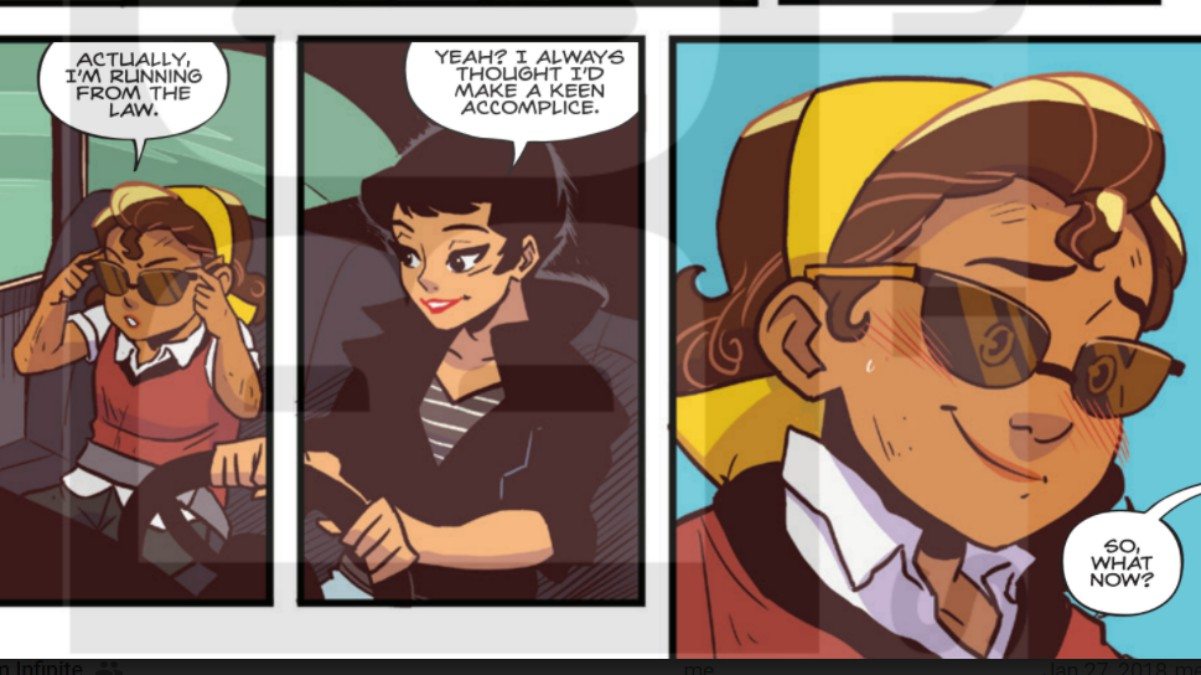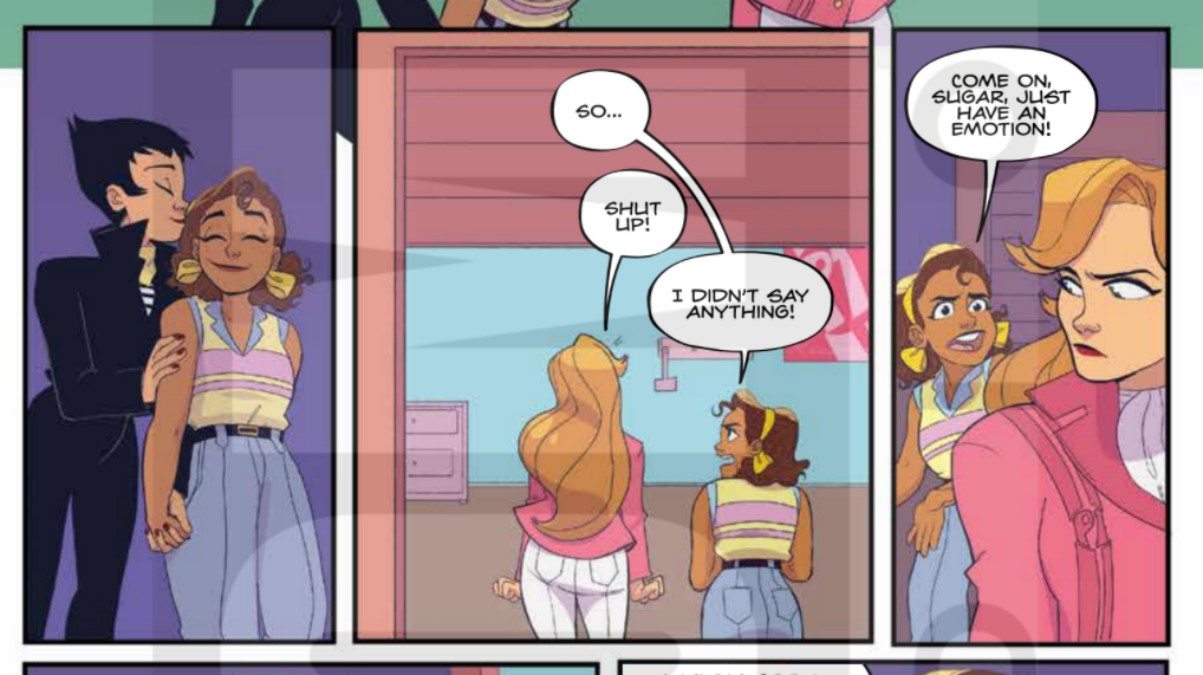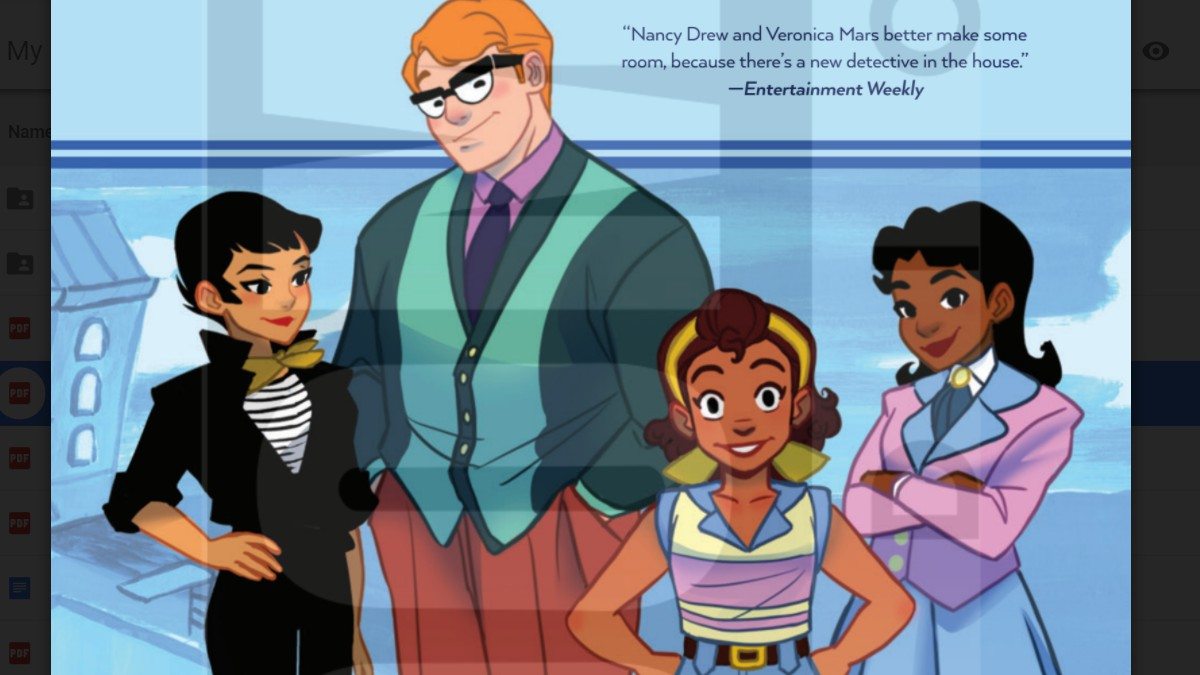
I should have heard about Goldie Vance a long time before I did.
You see, as a kid, I adored the Nancy Drew mystery series. Someone had given me a set of an older version of the books when I was 7 or 8 years old. I loved the adventures of Nancy and her friends Bess and George (for those not in the know, both Bess and George are girls; Bess is a more traditionally feminine character, while George is regularly described as a tomboy. George was also been read as a lesbian by all the queer girls I knew in the 90s). Nancy was an amateur detective who was always eager to help, was incredibly smart, regularly described as “feisty,” and never got flustered by circumstances. She had a boyfriend and her father who she could summon for help when things got dicey, but she rarely did. My first fandom was My Little Pony, but my second fandom was Nancy Drew.
What I didn’t realize until I was older was that the Nancy Drew I read was different from the Nancy Drews that had come before. Originally conceived in the 1930s by the same author who had created The Hardy Boys, Nancy evolved in the 1960s and again in the 1980s to (arguably; many readers do not agree) better reflect the girls who were reading at the time. In general, Nancy’s character is changed to become more compliant, less sassy, more “appropriate.” There was a lot more kissing, and a lot less of Nancy detecting on her own.
I had no use for the later Nancy Drew Files, where Nancy’s boyfriend Ned took on a bigger role and made Nancy a more sexual character, but I wore out those original hand-me-down hardcovers. There were several years in my childhood where Nancy, with her Titian hair (I was fully 20 years old before I found out what that meant; red hair that shades just a little brown) was my very best friend and my most powerful idol.
Which brings me to Goldie Vance.

I don’t know what the elevator pitch for Goldie Vance was, but if it was something other than “A mixed race gay Nancy Drew,” I’d be disappointed. I’ve read a lot of girl detective mysteries over the years that attempted to fall into the same category as my beloved Nancy; Goldie is the first one who hits that same sweet spot for me.
Now, a note: I generally refuse to refer to anything as the “girl” this or the “gay” that. This makes diversity a modifier of the norm, which is both obnoxious and incorrect. If I were recommending the title to a friend, I’d talk about the quality of the art, the quick and thorough development of character, and the mystery plots that are fun and readable for all ages. But elevator pitches are designed to catch someone’s attention, and to be entirely truthful, that’s what caught mine.
I had somehow missed Goldie Vance – a shame, since Boom! Box is putting out some amazing titles that my 10 year old adores – until the book turned up on the GLAAD Media Awards nominations. Since some other companies are doing a deplorable job of diversifying their offerings, I wanted to read deeper into the companies that were doing things right. To be clear from the get-go: I got these volumes as review copies through GeekMom, but I will be buying the paperbacks to add to our shelves at the soonest opportunity.
Here’s the basic set-up for Goldie Vance:
Goldie is a teenaged amateur detective. She lives in St. Pascal, Florida, and both she and her father work at the Crossed Palms Resort. He’s a manager, she’s a valet. She “volunteers” her time with the hotel detective agency; the hotel detective really wishes she would stop. Goldie’s parents are divorced, but they have an amicable relationship; Goldie’s mother works as a live mermaid in a theme restaurant, and occasionally tries to convince Goldie to join her mermaid life. Goldie would rather be racing cars; her love of cars figures into all three of the volumes.
Goldie is also gay (lesbian or bi). She has an onpage relationship with Diane, the badass girl who works at the local record store. The relationship is clear – the pair hold hands, kiss, go on dates, spend time together – but avoids the kind of hot-and-heavy make-out situations that make a book inappropriate for little kids. I don’t have the personal authority to speak to the quality of Goldie’s representation as a mixed race girl, or the other characters of color who make up most of the cast. I can say, with total confidence, that characters like Goldie would have done amazing things for my self-esteem as a young kid who grew up to be queer.
The magic of Goldie’s gayness is that nothing is really made of it. She and Diane get together, and no one says anything rude about it. Goldie and Diane don’t need to face down homophobic slurs (or racial ones). There’s no big coming out scene. They flirt, they go to a movie, and then they’re shown as girlfriends. Goldie keeps right on solving mysteries, and Diane remains a character in the sphere of Goldie’s life. She’s just part of the story.
This same “part of the story” experience extends to Cheryl, Goldie’s best friend. Cheryl is Black, and wants desperately to be an astronaut. No one tells her that it’s ridiculous for a Black girl in the 1960s to want to be an astronaut, but also no one tells her that she can just achieve her dream if she tries hard enough. Cheryl is just shown working her butt off to get to her dream. She studies hard, saves her money from her job at the Crossed Palms, and trains hard to meet the physical requirements to be an astronaut.
Throughout the three volumes of Goldie Vance that are currently available, the stories say smart things about relationships, friendships, understanding your enemies, and staying true to yourself, but they never descend into the sappy territory of an afterschool special.
All three volumes are written by Hope Larson, with Sarah Stern doing colors and Jim Campbell on letters. The first two volumes are illustrated by Brittney Williams; Noah Hayes takes over illustrations in volume three. Each volume can be read as a standalone, but if you read them in order, you get additional context. For example, Volume 3’s mystery revolves around who is sabotaging Sugar Maple’s race car. The story stands fine on its own, but Goldie’s desperation to touch a P1 engine is more understandable if you’ve seen her oogling cars throughout the previous two volumes. Goldie and Sugar slowly figuring out how to be friends is more moving if you’ve seen them as enemies for chapter after chapter.
The first volume (these are simply titled “Volume 1,” “Volume 2,” and “Volume 3,” with each issue as a Chapter) has a mystery centering around the scientist Dr. Dieter Ludwig and his attempt to escape Germany to join NASA.
The second volume concerns an astronaut who washes up on the beaches of St. Pascal and has no memory of how she got there.
The third volume has to do with Sugar Maple, daughter of the owner of Crossed Palms, and who is sabotaging her racing career.
Brittney Williams’ art in the first two volumes is awesome. Expressions are important, body language matters, and details in the background are important to later scenes. Both of these volumes got better on the second read, as I noticed more details which offered additional depth to the story. I’m particularly enamored of Diane and Goldie’s car ride in Volume 1 where they start gently flirting.

When Noah Hayes takes over illustrations in Volume 3, Goldie becomes a little more adult looking. I appreciated this, because while I loved Williams’ illustrations and style, Goldie seemed more like a preteen to me. Hayes keeps the soft and curvy lines to her figure while also making her seem, well, older. I could more easily see her as the 16 year old she’s supposed to be (same age as Nancy Drew, amateur sleuth). This seems to be Noah Hayes’s first professional credit, but he is now on my list of artists to watch.

In many ways, the art in Goldie Vance reminds me of the art I’ve seen in other media that I find very approachable for kids; the Bruce Timm work in the DCAU, Diesel, and other Boom! Box titles. Diane in particular reminds me of the Bruce Timm work in Batman Beyond. It’s fascinating watching the remix culture impact the styles of the new wave of professionals: Hayes’ art in particular is Bruce Timm character proportions by way of ligne claire, but with a propensity for expressive faces in a way that seems more in line with animated works like Wakfu. For those of you keeping score, that’s America, Belgium and France. If you don’t see the benefit in deliberately seeking things outside of your typical sphere of influence when you look at a page of Goldie Vance, I don’t know what to tell you.
As for kids who might just be getting into comics, it helps that there’s consistency to the art even during the switch (Williams’ art is still very Timm oriented, but with thicker inking), allowing them to focus on how the art influences and represents the story rather than have to switch tracks in re-interpreting a world’s vision through a new artist. That’s not to say that comics as a whole should have a consistent art style: I’m parent to a kid who happily switches back and forth between Don Rosa’s Life and Times of Scrooge McDuck, G. Willow Wilson’s Ms. Marvel, and Hidenori Kusaka’s Pokemon Adventures.
Goldie Vance does everything I like about comics. It provides an entertaining story that is both emotionally moving and leaves me thinking about it after I’m done. It’s clear about who it is for (kids). It remains accessible for those outside of its intended audience (adults). It provides exceptional representation for queer characters, potentially offering a lifeline to kids who don’t understand yet why they feel different, or who are in situations where it is not safe to share their identity with those around them. It normalizes these characters, not by being the Gay Girl Detective Comic, but by having a girl detective who is also gay. Not a peripheral detail, not something alluded to or only shown off-page, it’s there, without comment. Just as it should be. And even if I didn’t care about any of that at all, if this was the norm instead of the exception, I’d be singing Goldie Vance‘s praises for one simple reason: it’s a damn great comic.
Pick up:
Goldie Vance Vol. 1
Goldie Vance Vol. 2
Goldie Vance Vol. 3
Preorder Goldie Vance Vol. 4, available in May
20th Century Fox recently acquired the movie rights for Goldie Vance; so far Rashida Jones and Kerry Washington are attached as director and producer respectively.
Disclaimer: GeekMom received these comics for review purposes.



